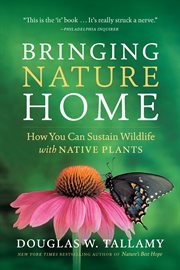Nonfiction
eBook
Details
PUBLISHED
Made available through hoopla
DESCRIPTION
1 online resource
ISBN/ISSN
LANGUAGE
NOTES
"A fascinating study of the trees, shrubs, and vines that feed the insects, birds, and other animals in the suburban garden." -The New York Times As development and habitat destruction accelerate, there are increasing pressures on wildlife populations. In Bringing Nature Home, Douglas W. Tallamy reveals the unbreakable link between native plant species and native wildlife-native insects cannot, or will not, eat alien plants. When native plants disappear, the insects disappear, impoverishing the food source for birds and other animals. But there is an important and simple step we can all take to help reverse this alarming trend: everyone with access to a patch of earth can make a significant contribution toward sustaining biodiversity by simply choosing native plants. By acting on Douglas Tallamy's practical and achievable recommendations, we can all make a difference. Now with expanded content and plant lists for regional habitats, Bringing Nature Home offer the insight needed for home gardeners to become backyard ecologists. Doug Tallamy is a professor in the Department of Entomology and Wildlife Ecology at the University of Delaware, where he has authored 97 research publications and has taught insect-related courses for 40 years. Chief among his research goals is to better understand the many ways insects interact with plants and how such interactions determine the diversity of animal communities. His book Bringing Nature Home, published by Timber Press in 2007, was awarded the 2008 Silver Medal by the Garden Writers' Association. Among his awards are the Garden Club of America Margaret Douglas Medal for Conservation and the Tom Dodd, Jr. Award of Excellence, the 2018 AHS B. Y. Morrison Communication Award, and the 2019 Cynthia Westcott Scientific Writing Award. Rick Darke is a landscape design consultant, author, lecturer, and photographer based in Pennsylvania who blends art, ecology, and cultural geography in the creation and conservation of livable landscapes. His projects include scenic byways, public gardens, corporate and collegiate campuses, mixed-use conservation developments, and residential gardens. Darke served on the staff of Longwood Gardens for twenty years and received the Scientific Award of the American Horticultural Society. His work has been featured in the New York Times and on National Public Radio. Darke is recognized as one of the world's experts on grasses and their use in public and private landscapes. For further information visit www.rickdarke.com. Restoring Natives to Suburbia: A Call to Action Gardeners enjoy their hobby for many reasons: a love of plants and nature, the satisfaction that comes from beautifying home and community, the pleasures of creative effort, the desire to collect rare or unusual species, and the healthful benefits of exercise and outdoor air. For some people, like my wife and me, there is pleasure in just watching plants grow. But now, for the first time in its history, gardening has taken on a role that transcends the needs of the gardener. Like it or not, gardeners have become important players in the management of our nation's wildlife. It is now within the power of individual gardeners to do something that we all dream of doing: to make a difference. In this case, the "difference" will be to the future of biodiversity, to the native plants and animals of North America and the ecosystems that sustain them. For decades, many horticulture writers have been pleading for a fresh appreciation of our American flora, and for almost as long they have been largely (or entirely) ignored. For several reasons, however, the day of the native ornamental is drawing near; the message is finally beginning to be heard. If I were to ask a random group of gardeners to comment on the importance of native plants in their garden
Mode of access: World Wide Web







